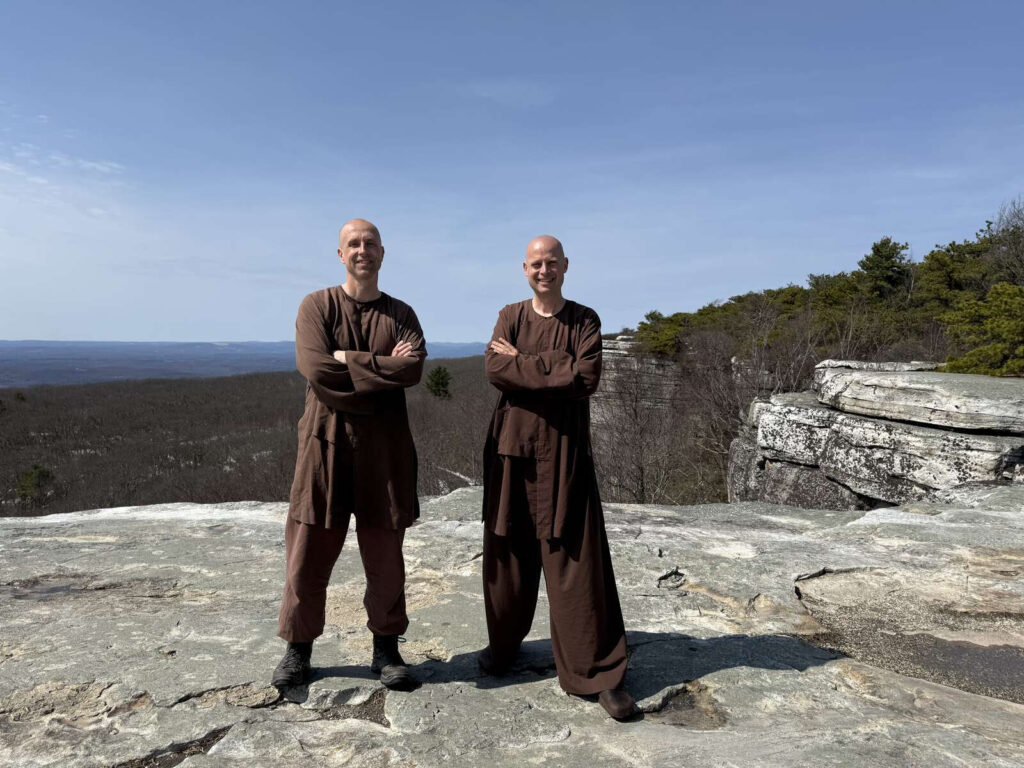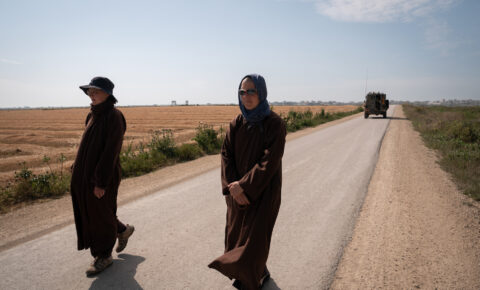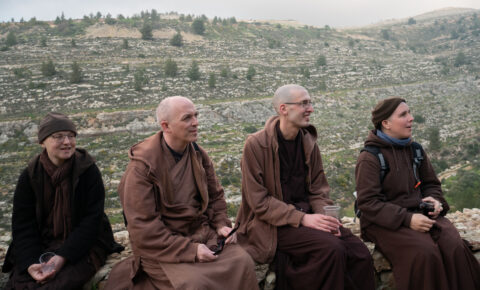In this reflection, Brothers Phap Xa and Phap Luu invite us into an experience of sensory awakening through mindful presence — grounded in a seven-week retreat on the Appalachian Trail that inspired their new book, Hiking Zen.

Br. Phap Xa: Four years after Brother Phap Luu and I decided to lead an extended mindful backpacking retreat on the Appalachian Trail, the idea had become reality. At the beginning of April 2018, a group of monastics and enthusiastic participants began hiking directly from one of our retreat centers, Blue Cliff Monastery in upstate New York. The retreat would last for seven weeks; participants would rotate each week, but the guiding monastic team would remain constant as we hiked from New York to Washington, DC. We hoped to arrive at the National Mall by the end of May to sit where Thay had sat in meditation with more than a hundred World Bank staff members six years prior. In doing so, we wanted to offer the support of our collective mindful presence to a nation that seemed caught in ever-deeper turmoil.
We set some ground rules about phone use. Following these guidelines, I use an app on a cell phone without a SIM card to help the group navigate during our second week on the trail. Though finding the white blazes that mark the trail isn’t difficult, we also have to look for suitable places to take breaks, fill up our water bottles, and set up camp for the night. The app makes all of this easier. Since we split into two hiking groups during the day, Lazy Monk — Brother Phap Khoi’s nickname — also has a phone. His has reception, and he occasionally uses it to contact the other hiking group or Mama Sue (Phap Luu’s actual mom!), who helps with organizational details and drives a support vehicle.
During the orientation at the start of the retreat, Brother Phap Luu and I had explained to the group how we’d use these two cell phones — the group only needed one navigational phone and one connected phone for emergencies, so everyone else could just take a digital break and enjoy their mindful practice in the woods. We encouraged participants not to use their phones so they could focus on being in touch with themselves, with nature, and with the other members of the group. Occasionally someone might use their phone to take a picture, which was fine.
The main point was for hikers not to distract themselves with their phones or use them to avoid noticing physical or emotional discomfort. Our pain, anxiety, and despair need our presence and attention to transform.
For Henry, one of the hikers on retreat this week, setting aside his phone is especially difficult. Most weeks of the retreat, we tend to experience a participant or two having trouble letting their phones rest, and this week it’s Henry. During every break, he whips out his phone to check the news. About three days into his week-long retreat, Henry gets tired and starts to complain nonstop. “Who thought of this stupid idea of a hiking retreat?” Lazy Monk hears him say.
It’s amazing to me, a modern monk who grew up in a largely analog world — I was born in 1974 — how quickly people have gotten addicted to digital media and cell phones. A word has even been coined — nomophobia — to describe the fear of being without a mobile phone.
Our addiction to being connected to the internet comes at a cost, though. It often means we’re not present for the people around us, much less for ourselves or our surroundings.
On the trail, Henry’s compulsion to check the news seems to fuel his mood swings. His engagement with his screen as well as his emotional volatility weighs on the group. Noticing this, we monastics commit to consciously staying connected to Henry with kind words and gentle smiles. We hope to create an environment that will help draw Henry out of the bubble of his phone.
For Henry, and for all the hikers, connecting to the natural elements and allowing themselves to be nourished through all their senses is the heart of the retreat.
During the two decades I’ve spent as a monk, I’ve witnessed many people going through darkness: grief from the loss of a loved one, tension at work, pain over a recent divorce, the numberless other difficulties that at some point or another cast a shadow over our lives. For me, being able to offer support just by being there and listening has been one of the most fulfilling parts of being a monk. I hardly have to say anything, I’ve realized. Just offering space to speak and be listened to is of immeasurable value. This week on the Appalachian Trail, I feel something going on under the surface for Henry and try to hold that space for him. As the week goes on, he never explicitly asks for help. I sense that he deeply longs for connection, yet doesn’t quite know how to seek or ask for it. Perhaps burying his nose in his phone frees him from having to figure a way out or risk hurt feelings.
It surprises us all, then, when Henry suddenly exclaims one evening, “This is just beautiful!” He’d just sat down at the end of a long day of complaining. As he looks around the group, he expresses appreciation for our company, our surroundings, and the present moment. I can scarcely believe my ears. Perhaps something has shifted for Henry. Perhaps the trees have pulled him in despite his addictive phone behavior, or the collective group mindfulness has seeped through. Whatever the process, for a moment at least, Henry’s distraction falls away, and he waters the seeds of presence and joy in himself and others.
Coming back to our breathing and sensing nature within and around us — the air that becomes breath in our bodies, the plants with which we build our cells, the water we drink and release — helps us to better understand the root of our emotions and often-mistaken perceptions in what can otherwise be a busy, overwhelming existence. This contact helps us understand the root of our being. It reminds us that, despite how hectic modern life can be, we remain embedded in the natural world of which we’re made.
Br. Phap Luu

Discover the joy of mindful walking and hiking, cultivate deep connection with the world around you, and ultimately embrace the path of happiness as a way of life.
Available now at Parallax Press or wherever books are sold.






Share Your Reflections